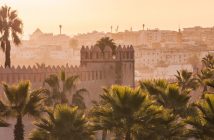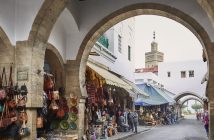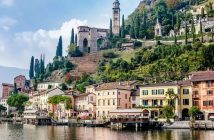Known locally as ’rounded bays’, tucked into the Persian Gulf, Angelina Villa discovers a city on the up. Culturally, stylistically, architecturally, Doha is reaching for the sky…
Shimmering in the distance, lighting up the darkness of the desert, the city of Doha is a dazzling sight. The cluster of electric-neon towers are bold against the night sky, and mark Doha out as a true incarnation of a 21st century metropolis, unrecognisable from the original pearling port it was just a few decades ago. But while other Middle Eastern cities, such as Dubai, have a ‘bigger is better’ philosophy, Doha’s skyline – albeit with its fair share of skyscrapers – seems to be more about gravitas and grace than vertiginous pride.
One of the most striking buildings in Qatar’s capital, for instance, is Doha Tower, designed by French starchitect Jean Novel, and overlooking Doha Bay. Standing at 761 feet, it is remarkable not because of its height but because of its delicate, lace-like layered façade inspired by Islamic shanasheel screens – making the building at once traditional and futuristic. With his ability to fuse both the old and new worlds that Doha represents, Nouvel was also called upon to design the new, much anticipated National Museum of Qatar, a work in progress, due to open in 2016 (www.qm.org.qa/en/project/national-museum-qatar). “Giving voice to Qatar’s heritage, while celebrating its future” is its tagline, and you can see the building’s innovative interlocking disc design, which is meant to look like a desert rose growing out of the ground, taking its final shape.
Based on the Persian Gulf and bordering Saudi Arabia, Qatar’s capital may now be on the map for football fans the world over – it being the controversial host of the World Cup in 2022 – but it has long been overshadowed by glitzier Middle Eastern destinations. The government aims to right that with a bigger plan for itself beyond the World Cup aiming to mark out Doha as one of the world’s cultural capitals and a hub for well-heeled travellers. As a consequence, everywhere you look there are new state-of-the-art buildings, impressive museums, glitzy hotels and fantastical restaurants springing up across this desert and sea-fringed city. Big names from the arts, design and culinary worlds are also flocking here to be part of the action, making it a buzzy, exciting place to be.
Another jewel in Doha’s cultural crown – the Museum of Islamic Art (www.mia.org.qa) – offers food for both the soul and body. Housing a rich collection of varied pieces spanning 1,400 years, it stands in an iconic building, on Doha’s Corniche, and was designed by world-renowned architect I.M. Pei. Drawing influence from traditional Islamic architecture, the stark limestone building captures hourly changes in light and shade and has a glorious rooftop terrace with views over Doha’s skyline. Best of all is its very special in-house restaurant IDAM, Alain Ducasse’s first restaurant in the Middle East, with a sophisticated decor designed by Philippe Starck.
Ducasse is in fact just one of the many world-renowned chefs with restaurants in the city. While culture is high on the agenda, so is culinary prowess, with many of the ‘great and good’ of the gourmet world opening up ‘shop’. Following on the heels of two Jean-Georges Vongerichten restaurants (Market and Spice Market) at the W Doha (www.whoteldoha.com) and Gordon Ramsay’s Doha at the St Regis Hotel, West Bay (www.stregisdoha.com), is the just-opened Nobu at the Four Seasons Hotel Doha (www.fourseasons.com/doha). While the Four Seasons itself is known for its grand, traditional interiors, its new Nobu outpost – located on its own private marina beyond the hotel – epitomises the very latest in seductive urban glamour.
Conceived by David Rockwell to resemble a coiled pearl shell, the sprawling, three-floored restaurant is the largest outpost by chef Matsuhisa in the world (at 26,000 square feet) and pays tribute to the city’s pearl diving history. From its roof-top lounge to its dramatic open-plan dining room, the circular restaurant uses natural materials to form a multi-layered ambience: think bronze accents, ribbons of stone, textured wood and shimmering glass baubles for lights. It is an apt setting for the stand-out Japanese food Nobu is known for. As well as his repertoire of signature dishes (black cod miso and yellowtail sashimi with jalapeno), the menu boasts new creations using local ingredients and a unique tapas style menu (the grilled umami chicken wings with miso salt and the wagyu beef gyoza butter ponzu sauce are to die for).
Seasoned travellers would do well to base themselves at the Four Seasons Doha. While the large rooms, with neutral but pleasing colour palettes, are perhaps the least interesting part of the hotel – they are nonetheless luxurious (nothing less will do here). Instead, the spotlight in this hotel is on the public areas – a standout waterfront spa, inviting tea lounge and authentic shisha lounge are vibrant places to hang out, whether it is for some me-time or to mingle with the local movers and shakers who gather here.
For a buzzier, younger scene – check in at the W Doha in the West Bay area, which has a Bliss Spa, sophisticated eateries and specially curated events. Rooms are curvy and cocooning (many are circular to reflect the local pearls which was once the only industry that existed in Doha) while the suites have stunning views over the Arabian Gulf and dramatic interiors.
As a city on the move, it’s easy to be wowed by the glitz of the new. Just as rewarding, though, are some of the more authentically Middle Eastern places to visit. Souq Waqif is one of these: a labyrinth of small shops selling anything from fresh dates to pottery, handicrafts to everyday merchandise. Here you’ll mix with locals who are shopping or simply chatting over coffee. It’s noisy, friendly and scented with oud from the perfume shops. There are material shops aplenty – white cotton stacked up in the windows to make the immaculate thoubs (long tunics work over trousers) that men wear and piles of black cloth for the women’s djelabia (long dresses) – it turns out there are many variations – in the hundreds – of shades of white and black.
Another local haunt is the Doha Corniche, a 7km-long waterfront promenade that stretches in a semi-circle around Doha Bay – great for leisurely evening strolls (much like how the Italians take their passeggiata, this is popular pastime with families) and to see the traditional wooden dhows bobbing in the bay. Also worth a bumpy trip across the sand dunes is the strange place that is Khor al Adaid or Inland Sea, found 60km south of Doha and only accessible in a 4×4 with a guide. A UNESCO recognized nature reserve, it is one of the few places in the world where the sea encroaches deep into the heart of the desert and makes for a unique spectacle. Like many of the world’s most memorable places, it’s weird and wonderful.
Much like Doha itself.
EXSUS offer five nights in Qatar for £1,659 per person. Based on two nights at The W Doha and three nights at The Four Seasons Doha. The price includes airport transfers and return flights from London to Doha with Qatar Airways, 0207 337 9010; www.exsus.com
Qatar International Adventures offers a range of tours including Desert Safaris, Doha City Tours and Museum Tours, www.qia-qatar.com
For more information on Qatar visit www.qatartourism.gov.qa




